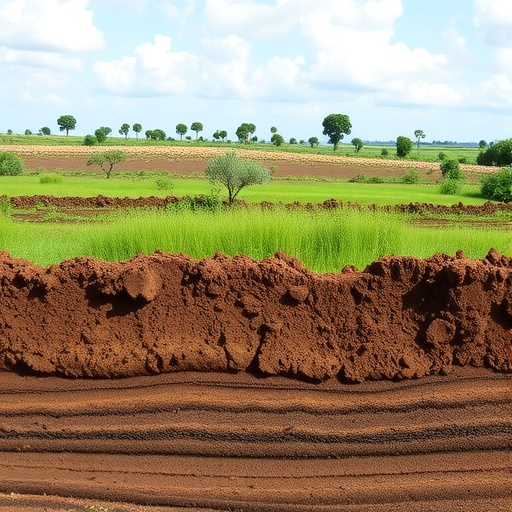In a groundbreaking study, researchers have meticulously evaluated the consequences of land use and land cover changes on soil erosion potential in the Gimbora River catchment, located within the Gubalafto Woreda in Ethiopia’s Amhara Region. Given the increasing pressures on natural ecosystems from anthropogenic activities, understanding these changes has become critically important. This research aims to quantify the effects of various land use practices on the landscape’s ability to retain soil, highlighting the need for sustainable management practices.
Soil erosion, a vital environmental concern, results primarily from human activity such as deforestation, agricultural expansion, and urbanization. The Gimbora River catchment, known for its diverse topography and climate, has not been immune to these shifts. As agricultural practices evolve, the natural vegetation cover has diminished, leading to increased vulnerability of the soil structure. This study utilized advanced remote sensing technologies and Geographic Information Systems (GIS) to monitor land use changes and assess their implications on soil erosion risk throughout the region.
The methodology employed in this study involved a multi-faceted approach, integrating satellite imagery analysis to identify significant land cover changes over a specified timeline. By analyzing historical and current data, the researchers were able to pinpoint alterations in land use, particularly differentiating between cultivated lands, grazing areas, and forested regions. This quantitative assessment provides a robust foundation for understanding the dynamics of soil erosion within the catchment area.
One of the key findings of this research is the direct correlation between the expansion of agricultural lands and the increase in soil erosion potential. As farmers convert forested areas into cropland, the protective cover that trees provide is lost, which accelerates surface runoff and soil degradation. This finding raises urgent questions regarding the implications of unsustainable land practices on long-term agricultural productivity and ecosystem health in the region.
Additionally, the study outlines how traditional farming practices, often reliant on slash-and-burn techniques, contribute significantly to soil erosion. Such methods, aimed at clearing land for agriculture, inherently compromise soil quality and lead to further erosion. The researchers advocate for improved agricultural practices that could mitigate these effects, such as the introduction of crop rotation and agroforestry methods that preserve soil integrity and enhance its resilience.
Another critical aspect examined in the study is the role of topography in influencing soil erosion patterns. The varying slopes and elevation gradients within Gimbora River catchment create distinct hydrological responses, affecting how water interacts with the soil during rainfall events. The research emphasizes the need for site-specific strategies to manage erosion risk, particularly in areas with steeper gradients where runoff is exacerbated, thus prompting more intense soil washing.
The results from this study not only underscore the urgent need for sustainable land management practices but also highlight the potential consequences of neglecting these practices. As soil erosion continues to threaten agricultural viability and ecosystem functionality, the researchers call for policy interventions and community engagement to promote awareness and adoption of sustainable techniques.
Moreover, the study illustrates the importance of integrating scientific knowledge with local practices to develop effective strategies for combating soil erosion. Educational initiatives focusing on the benefits of maintaining vegetation cover and practicing sustainable farming methods could play a vital role in empowering farmers to make informed decisions. Such collaboration could facilitate more effective land management that balances agricultural needs with environmental health.
Community involvement emerges as a pivotal element in addressing soil erosion issues. By fostering dialogue between researchers and local populations, the potential for sustainable practices to take root becomes significantly enhanced. Community-led initiatives could include reforestation efforts and the establishment of local conservation programs designed to protect not only agricultural lands but also critical watershed areas.
In addition to the local environmental benefits, effective soil management can have far-reaching implications for climate change mitigation. Healthy soils act as carbon sinks, absorbing CO2 from the atmosphere. Therefore, addressing soil erosion in the Gimbora River catchment not only aids in local agricultural resilience but also contributes to broader global climate goals. This multifaceted approach emphasizes the interconnected nature of environmental health, agricultural practices, and climate stability.
The necessity of interdisciplinary approaches in addressing soil erosion issues is poignant. By incorporating ecological, agricultural, and social sciences, researchers can develop more comprehensive strategies that address the multifarious causes of soil erosion. This study serves as a model for future investigations in similar contexts around the world, where land use changes threaten soil integrity and ecosystem services.
As the research concludes, researchers reiterate the urgency of adopting sustainable land management practices. Long-term solutions are essential for ensuring that soil erosion does not compromise agricultural production and the wellbeing of communities dependent on the land. This study’s findings call for immediate action, advocating for the integration of scientific research with local knowledge to foster a more sustainable future for the Gimbora River catchment and beyond.
In summary, the study elaborates on the complex relationship between land use changes and soil erosion potential within the Gimbora River catchment. Through meticulous research, the implications of agricultural expansion, topographical influences, and the role of sustainable practices are brought to the forefront. Moving forward, the findings serve as a crucial reminder of the responsibilities borne by both policymakers and local communities in safeguarding the environment through informed and sustainable practices.
Subject of Research: Impact of land use and land cover change on soil erosion potential.
Article Title: Assessing the impact of land use and land cover change on soil erosion potential in Gimbora river catchment of Gubalafto Woreda, Amhara Region, Ethiopia.
Article References:
Ale, A., Mohammed Ali, A., Ayalew, S. et al. Assessing the impact of land use and land cover change on soil erosion potential in Gimbora river catchment of Gubalafto Woreda, Amhara Region, Ethiopia.
Discov Sustain 6, 852 (2025). https://doi.org/10.1007/s43621-025-01646-3
Image Credits: AI Generated
DOI:
Keywords: Soil erosion, land use change, sustainable practices, Gimbora River catchment, Ethiopia.




